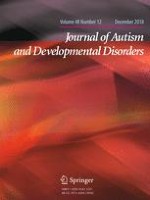03-07-2018 | Original Paper
An Investigation of Gelotophobia in Individuals with a Diagnosis of High-Functioning Autism Spectrum Disorder
Gepubliceerd in: Journal of Autism and Developmental Disorders | Uitgave 12/2018
Log in om toegang te krijgenAbstract
Samson et al. (Journal of Autism and Developmental Disorders 41:475–483, 2011) conducted the first empirical investigation examining the fear of being laughed at (gelotophobia) and its prevalence in individuals with high-functioning autism spectrum disorder (hfASD). The present research examined gelotophobia in relation to social functioning, perceived social support, life satisfaction and quality of life (QoL) in individuals with hfASD, including past experiences of bullying and the presence of comorbid psychopathology. Participants were 103 adults with a clinical diagnosis of hfASD and 137 typically developing controls. Individuals with hfASD presented with higher rates of gelotophobia symptomatology in comparison to controls (87.4 vs. 22.6% respectively). It was also found that social functioning, past experiences of bullying, anxiety and life satisfaction were predictors of gelotophobia amongst individuals with hfASD.
